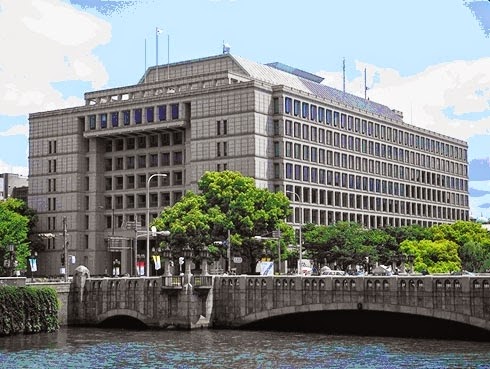Nakanoshima is originally a sandbank lying between two rivers and it isn't an artificial reclaimed land. The development of Nakanoshima was started in 1615 by a rich merchant, which made it and its surrounding areas to be the commercial center of Osaka.
During Edo period (16-18th century), Nakanosima had been playing a role as a kind of financial market like the wall street in today's USA. In fact, activities of rice futures contract flourished there from 18th century, and it was the world's first ever market for futures contract.
In those days, salaries of government officials, namely Samurais, were paid in rice which was gathered from farmers as a tax. Before paid to samurai, the rice was once transported to Nakanosima from all over Japan and then conveyed to every region of Japan. Therefore, Nakanosima had been functioning as a hub market for rice.
This is the illustration of rice market in Edo period. A lot of rice bags are stacked in front of warehouse stood by the Dojima river.
Chuo Kokaido, which was completed in 1918, is probably the most featured building in Nakanosima. It has provided a place for a lot of lectures and conferences; Albert Einstein, Helen Keller, and Yuri Gagarin delivered their lecture there. Nowadays, it is popular also as a sketching spot with a lot of students and elderlies sketching it in fine holiday.
The plan for constructing Chuo Kokaido was made possible with a donation of one million yen by Einosuke Iwamoto, a stockbroker who had an experience of visiting America and being impressed by American millionaires' donation for public services.
After that, he unfortunately failed at stock trading because of dynamic fluctuations in the market affected by World War I. Finally, he did a suicide with his pistol which he had acquired in his army days. It was before the complete of Chuo Kokaido. He also left a farewell poem and its English translation is following: Red leaves are falling, not waiting for the end of autumn".
Also Osaka City Hall building is located there, going through several times of rebuilding over its more than 100 years history. Currently existing city hall is the fourth version of it.
This is the third version of the city hall and it had been used from 1921 to 1982.
Osaka City Hall is located on the Midosuji Street, facing Bank of Japan, Japanese central bank.
This is the Osaka branch of Bank of Japan completed in 1903. People at large can go there on field trip by applying in advance.
And this is Nakanoshima Library constructed with the donation from Sumitomo Financial group, completed and opened in 1904.
As you can see, it has so traditional and august appearance that people living in Osaka are taking great pride in it. That sentiment, however, became clear when mayor Hashimoto and governor Matsui implied the possibility of its abolition in 2012.
While that statement, needless to say, encountered sever criticism, the board of education of Osaka announced that the abolition plan was only one of the options as to how to use the facility in future, which virtually denied the two politicians' radical statements.
Nakanoshima is an island-like land located between two rivers: the Okawa and Tosabori. Those two rivers are branched off from the river Okawa, and it also branched off from the river Yodo, the most famous river in Osaka. There are so many bridges running over Nakanoshima, and including minor bridges, the number of these bridges reaches 23.
Most of public institutions of Osaka are concentrated in Nakanoshima area.That area, so to speak, is a Washington, D.C.-like place of Osaka, though its scale can not be compared with D.C. In addition, it has, like the wall street, the nature of financial capital as I mentioned above. To sum it up, Nakanoshima is the place which is definitely different from downtown such as Numba and Umeda.
As for the access, I recommend you to use the subway Midosuji line. Yodoyabashi station, the nearest station to Nakanoshima, is the first station from Umeda. Or if you have time enough to do so, it would be nice to walk from Umeda to Yodoyabashi. The way is anything but wonderful, but it never is an unpleasant way.
Last of all, viewing from architectural perspective, The National Museum of Art, Osaka (NMAO) is one of the must-see spots in Nakanoshima. NMAO is planed by Cesar Pelli, the Argentine-born American architecture, and completed in 2004. It originally located in the vacant lot of Expo Osaka held in Suita, Osaka in 1970. It mainly exhibits modern art works from domestic and foreign artists. As for pre WWII art works, there are some masterpieces of Paul Cezanne, Pablo Picasso, Max Ernst, and so on.












